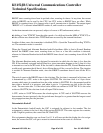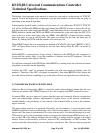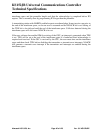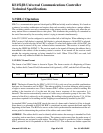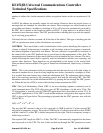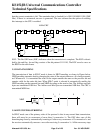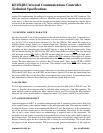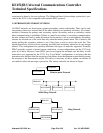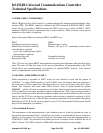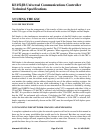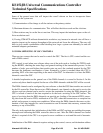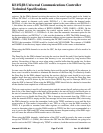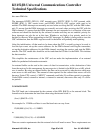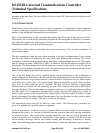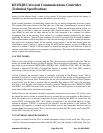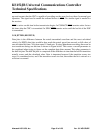
KS152JB Universal Communications Controller
Technical Specifications
Kawasaki LSI USA, Inc. Page 54 of 120 Ver. 0.9 KS152JB2
3.3.9 HDLC/SDLC COMPARISON
HDLC (High level Data Link Control) is a standard adopted by the International Standards Orga-
nization (ISO). The HDLC standard is defined in the ISO document # ISO6159 -HDLC unbal-
anced classes of procedure. IBM developed the SDLC protocol as a subset of HDLC. SDLC
confirms to HDLC protocol requirements, but is more restrictive. SDLC contains a more precise
definition on the modes of operation.
Some of the major differences between SDLC and HDLC are:
SDLC HDLC
Unbalanced (primary/secondary) Balanced (peer to peer)
Modulo 8(no extensions allowed, Modulo 128 (up to 127 outstanding frames before
acknowledge is required)
up to 7 out-standing frames before
acknowledge is required)
8-bit addressing only Extended addressing
Byte aligned data Variable size of data
The C152 does not support HDLC implementation requiring data alignment other than byte align-
ment. The user will find that many of the protocol parameters are programmable in the C152
which allows easy implementation of proprietary or standard HDLC network. User software
needs to implement the control field functions.
3.3.10 USING A PREAMBLE IN SDLC
When transmitting a preamble in SDLC mode, the user should be aware that the pattern of
10101010.....is output. NRZI encoding is used in SDLC when the internal baud rate generator is
the clock source and this means that a transition will occur every two bit times, when a 0 is trans-
mitted. This compares with some others SDLC devices, most of which transmit the pattern
00000000..... which will cause a transition every bit time. Our past experience has shown that the
C152 preamble does not cause a problem with most other devices. This is because the preamble is
used only to define the relative bit time boundaries within some variation allowed by the receiving
station, and the C152 does not have any problems with receiving a preamble consisting of all 0s.
One note of caution however. If idle fill flags are used in conjunction with a preamble, the address
00(00)H and 55(55) H should not be assigned to any C152 as the preamble following the idle fill
flags will be interpreted as an address.
3.4 User Defined Protocols
The explanation on the implementation of user defined protocols would go beyond the scope of
this manual, but examining Table 3.1 should give the reader a consolidated list of most of the pos-
sibilities. In this manual, any deviation from the documents that cover the implementation of
CSMA/CD or SDLC are considered user defined protocols. Examples of this would be the use of
SDLC with the 32-bit CRC selected or CSMA/CD with hardware based acknowledge.



